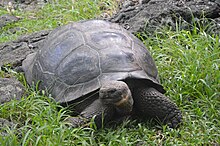Asilo de la Paz (English: Haven of Peace) is a location on Floreana Island in the Galapagos archipelago. It is the site of Floreana's first human settlement, and is now among the island's most popular tourist attractions. The site has a maximum elevation of 450 meters above sea level.

History
In August 1932, Heinz Wittmer, his wife Margret, and Heinz's son Harry, moved to Floreana from Cologne, Germany. They initially lived in a cave at Asilo de la Paz, near a spring that provided the island's only permanent source of freshwater. On 1 January 1933, Margret gave birth to Rolf Wittmer (1933–2011) inside one of the caves; he was the first person born in the Galapagos. At this site, the family built a home, with a roof made from tanned hides and banana leaves, and named it "Casa de la Paz" (English: House of Peace). They grew vegetables all year round and used the nearby caves as pig-pens, smokehouses, and storehouses. The Wittmers remained at the site until 1950, when they moved from the Floreana highlands to Black Beach.
Wildlife

Asilo de la Paz contains an area of intact Scalesia forest that provides important habitat for multiple species of Darwin's finch, including the critically endangered medium tree finch (Camarhynchus pauper). A warbler finch (Certhidea fusca), previously considered extinct on Floreana, was reportedly heard at Asilo de la Paz in 2008, although this sighting is not universally accepted. Giant tortoises, previously owned as pets by the island's residents, roam a large enclosed area at Asilo de la Paz. These tortoises are a mixture of species from other islands, since Floreana's native tortoise, Chelonoidis elephantopus, has been extinct on the island since shortly after 1835.
See also
References
- ^ Allison Amend (2017) "In the Footsteps of Charles Darwin" The New York Times. Published June 20, 2017. Accessed March 23, 2020.
- E. Ruiz-Ballesteros & Brondizio, E. S. (2013). Building negotiated agreement: The emergence of community-based tourism in Floreana (Galapagos Islands). Human Organization, 323-335.
- ^ Jody A. O'Connor, Frank J. Sulloway & Sonia Kleindorfer (2010) "Avian population survey in the Floreana highlands: is Darwin's Medium Tree Finch declining in remnant patches of Scalesia forest?" Bird Conservation International, 20(4): 343-353.
- ^ Moore, Randy (2021). Galápagos: An encyclopedia of geography, history, and culture. Santa Barbara, CA: ABC-CLIO. p. 355. ISBN 978-1-4408-6469-8.
- Michael Dvorak, Erwin Nemeth, Beate Wendelin, Patricio Herrera, Denis Mosquera, David Anchundia, Christian Sevilla, Sabine Tebbich & Birgit Fessl (2017). "Conservation status of landbirds on Floreana: the smallest inhabited Galápagos Island". Journal of Field Ornithology, 88(2): 132-145.
- ^ Emma Marris (2017) "Resurrecting a Long-Lost Galapagos Giant Tortoise" Wired. Published September 14, 2017. Accessed March 23, 2020.
- Ryan C. Garrick, Edgar Benavides, Michael A. Russello, James P. Gibbs, Nikos Poulakakis, Kirstin B. Dion, Chaz Hyseni et al. (2012) "Genetic rediscovery of an ‘extinct’ Galápagos giant tortoise species". Current Biology, 22(1): R10-R11.